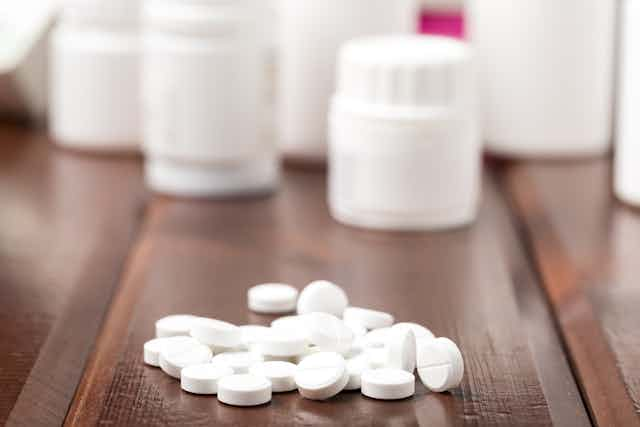This is the first article in our new ongoing series Weekly Dose, running every Wednesday. Articles will profile a different drug each week: how it works, what it’s used for, and other interesting facts.
Lipitor is the main drug from a family of medicines called statins, which are used to lower blood cholesterol levels. Other drugs in this class include: fluvastatin, pravastatin, rosuvastatin and simvastatin.
Generic versions of the drug are available and are sold under the name atorvastatin. Lipitor and atorvastatin contain the exact same active pharmaceutical ingredient (drug molecule) and are equally effective.

History
Lipitor was first synthesised in 1985 by Dr Bruce Roth, a chemist working for the pharmaceutical company Warner-Lambert.
While under development, and before the company could get government approval for Lipitor, three other statin-based drugs beat it to the market. As such, the Warner-Lambert executives didn’t think there would be much of a market for Lipitor and the company almost stopped its development.
All that changed when the first human trials of Lipitor showed that not only did it work, but it worked much better than the other statins. In fact, it worked so well it was given the nickname Turbostatin.
Lipitor was first approved in 1997. While under patent protection it was the highest-selling drug of all time, with worldwide sales at one stage of more than US$12 billion a year.
How it works
The human body requires a constant supply of a fat called cholesterol, which it uses to make hormones, bile and vitamin D.
Unfortunately, when someone has a diet high in cholesterol, the body has too much and it ends up getting deposited in their arteries by low-density lipoprotein (LDL), a type of cholesterol transport vehicle in the body known as “bad cholesterol”.
Deposition of cholesterol in the arteries increases the risk of high blood pressure, heart attack and stroke.
Lipitor acts in the liver to stop the production of cholesterol, which has the flow-on effect of lowering the amount of LDL in the bloodstream. A daily dose of 40mg can be enough to reduce LDL levels by almost 50%.
Lipitor is supplied in packs of 30 as round, white tablets with the letters ATV stamped on one side and the dose (10mg to 80mg) stamped on the other side.

Who should be taking Lipitor?
A doctor may prescribe Lipitor for her patient if they are in any one or more of the following high-risk categories with:
• a significant family history of heart disease
• diabetes, and the patient is over 60 years of age
• diabetes, and the patient is of Aboriginal or Torres Strait Islander descent
• diabetes and microalbuminuria (when the kidney leaks albumin – a protein in the blood – into the urine)
• if they have suffered from coronary heart disease, cerebrovascular disease (such as stroke), or peripheral vascular disease (circulation disorders in the vessels outside the heart and brain).
Other indications a doctor will take into consideration is whether her patient has high levels of blood cholesterol or high blood pressure.
Controversy
In October 2013, the ABC science program Catalyst ran a two-part episode called Heart of the Matter, which looked at the cause of heart disease and the effectiveness of statins. This included Lipitor.
The episode was largely criticised by the scientific community for the program’s use of unqualified experts and the amount of airtime given to controversial theories. The ABC later admitted the episode was flawed and pulled it from further view on its website, but the damage was done.
Since then, researchers at the University of Sydney have found that as many as 60,000 patients stopped taking statins as a result of the show. From this, they predicted there would potentially be up to 3,000 otherwise preventable heart attacks and strokes in the following years.
Side effects
Like all medicines, patients can experience side effects from the use of Lipitor. Common side effects include headache, sleep disturbance, dizziness and muscle pain. Rare side effects can include memory loss, allergic reaction, liver failure and nerve damage.
The use of statins, including Lipitor, is associated with an increased risk of new-onset diabetes. The drug is not recommended for children, or for women who are breastfeeding or planning on becoming pregnant.
Interesting fact: Patients taking Lipitor are advised not to drink grapefruit juice as it can increase the amount of the drug in their bloodstream, and therefore increase their chance of experiencing side effects.
Cost
Lipitor is covered by the Pharmaceutical Benefits Scheme. This means the federal government covers most of the cost. The price a patient pays in the pharmacy will depend on the dose their doctor has prescribed. The maximum price for the lowest dose (10mg) is A$18.91 for 30 tablets, while the price for 80mg tablets is A$24.79.
Clinical information provided in this article is based primarily on the Australian Medicines Handbook 2016. If you would like more information, the consumer medicine information sheet on Lipitor is available here.

